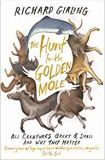The Hunt for the Golden Mole: All Creatures Great and Small and Why They Matter by Richard Girling
| The Hunt for the Golden Mole: All Creatures Great and Small and Why They Matter by Richard Girling | |
|
| |
| Category: Animals and Wildlife | |
| Reviewer: Rebecca Foster | |
| Summary: From Victorian animal collecting to present-day poaching, Girling surveys the contradictory human instincts toward exploitation and preservation of mammals. The book is rather scattered, but the message about species extinction is powerful. | |
| Buy? Maybe | Borrow? Yes |
| Pages: 320 | Date: June 2015 |
| Publisher: Vintage | |
| ISBN: 9780099571933 | |
| Video:
| |
At age 15, on a camping trip to Dartmoor, Richard Girling had an epiphany. It was the first time that he had felt himself to be a part of nature, that the environment really mattered to him. As a big picture person, however, this had never translated into an affinity for individual species, even though he became a longstanding environmental writer for the Sunday Times. That is, until he came across a mysterious listing for the Somali golden mole in a mammal encyclopaedia. This creature has never been seen in the wild, except as a few bones in an owl pellet found by an Italian zoologist in 1964. For some reason, the golden mole captured Girling's imagination, becoming a symbol of rarity and the fragility of mammals' existence.
For Girling this sparks a long digression into the history of our relationship with other species. The Victorians were enthusiastic about encountering animals, but unsentimental about them. There was no contradiction in those days between loving animals and hunting and eating them. In fact, Girling observes, it's only because of Victorian hunters that we have the Natural History Museum and London Zoo collections. We cannot judge the Victorians by our own standards. Even today we are full of inconsistencies: we think nothing of trapping rabbits and moles, and many of us are carnivores despite valid arguments against meat eating.
I struggled to see the total relevance of these first four chapters, so the book started off slowly for me. If I wanted to read about Victorian eccentrics like Roualeyn Gordon-Cumming, I would seek out a biography. These chapters are also peppered with long quotations from historical works; there is not enough of Girling's own analysis. It is not until he starts discussing early predictions of environmental disaster and rudimentary conservation efforts that the book starts to take on a clear direction. We have a broader knowledge of animal life now, Girling acknowledges, thanks to television personalities like David Attenborough, but ignorance and prejudice persist, as in the case of urban foxes.
Three chapters at the heart of the book are a collective highlight. 'Resurrection' is about species that have come back from presumed extinction. A recent study found that up to one third of species considered extinct may not be, while species new to Western science are still being discovered all the time. 'Chopsticks' is a particularly depressing chapter about the illegal ivory trade, perhaps too reliant on statistics but revealing nonetheless. In 'Ol Pejeta', Girling visits a conservancy in Kenya to see the wealth of African wildlife first hand. Due to the risk of poaching, the reserve's rhinos double or triple the cost of security.
'Optimism is the base metal of all conservation projects,' Girling writes, but 'hope and experience … are on different trajectories.' Like Elizabeth Kolbert's Pulitzer Prize-winning The Sixth Extinction, this is a dispiriting book to read because with the greed and carelessness inherent to human nature it seems like saving species is a lost cause. Girling states the case bluntly: 'Either we feel enriched by the presence of other species, and will honour their right to exist, or we don't.' All the evidence for how we have treated animals as commodities over the centuries seems to point towards the latter. Even where we have the knowledge and tools to save a species, we sometimes fail, as in the example Girling gives of the baiji, or Yangtze River dolphin.
Luckily, the golden mole is a totem with almost religious value: 'just because you can't see something, it doesn't mean it isn't there.' In a terrific final chapter, Girling travels to Florence to meet Dr Simonetta, the 82-year-old who discovered the Somali golden mole (among a dozen other species). There at La Specola, the world's oldest science museum, he sees the tiny mandible and ear bones that constitute the only evidence of the golden mole.
Ultimately, I found this book scattered and unfocused, with too little about the actual quest for the mole. Still, I can see it being a useful introduction for animal lovers who may be unaware of the desperate crises facing wildlife today. 'In its very obscurity the mole stands as a symbol for the whole unsung, unheard-of majority of mammalian life,' Girling writes. If the book inspires wonder and appreciation for biodiversity, it will have fulfilled its purpose.
Further reading suggestion: A Buzz in the Meadow by Dave Goulson is an excellent work of popular science that touches on similar issues of species exploitation and extinction.
Please share on: ![]() Facebook,
Facebook, ![]() Twitter and
Twitter and
![]() Instagram
Instagram
![]() You can read more book reviews or buy The Hunt for the Golden Mole: All Creatures Great and Small and Why They Matter by Richard Girling at Amazon.co.uk Amazon currently charges £2.99 for standard delivery for orders under £20, over which delivery is free.
You can read more book reviews or buy The Hunt for the Golden Mole: All Creatures Great and Small and Why They Matter by Richard Girling at Amazon.co.uk Amazon currently charges £2.99 for standard delivery for orders under £20, over which delivery is free.
![]() You can read more book reviews or buy The Hunt for the Golden Mole: All Creatures Great and Small and Why They Matter by Richard Girling at Amazon.com.
You can read more book reviews or buy The Hunt for the Golden Mole: All Creatures Great and Small and Why They Matter by Richard Girling at Amazon.com.
Comments
Like to comment on this review?
Just send us an email and we'll put the best up on the site.


